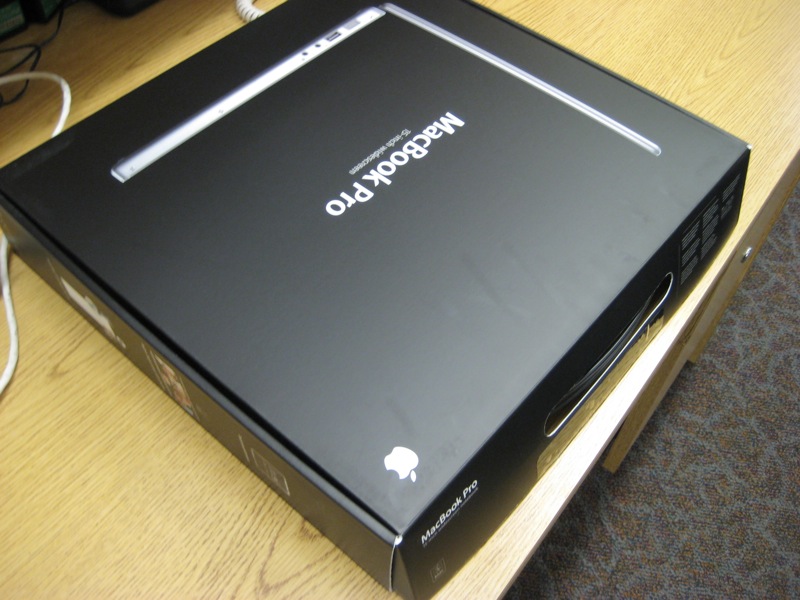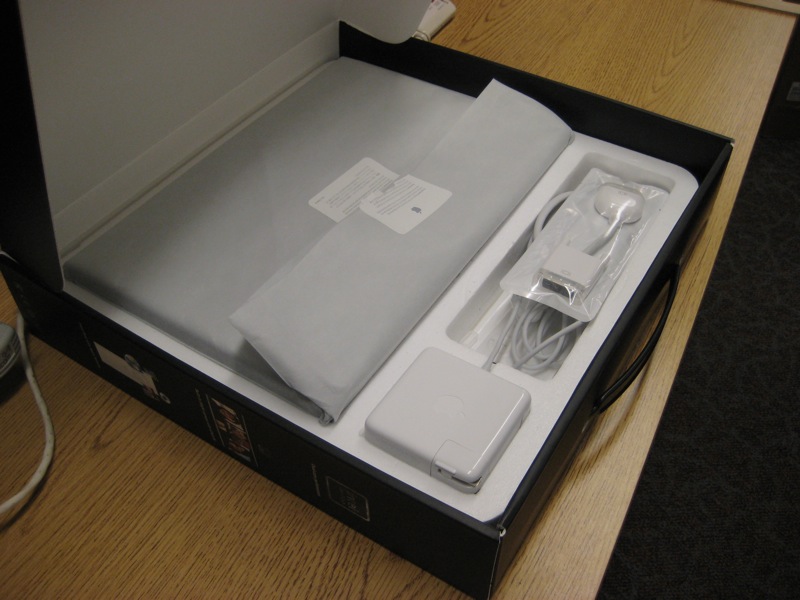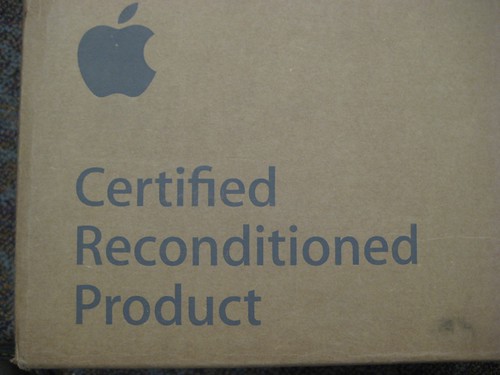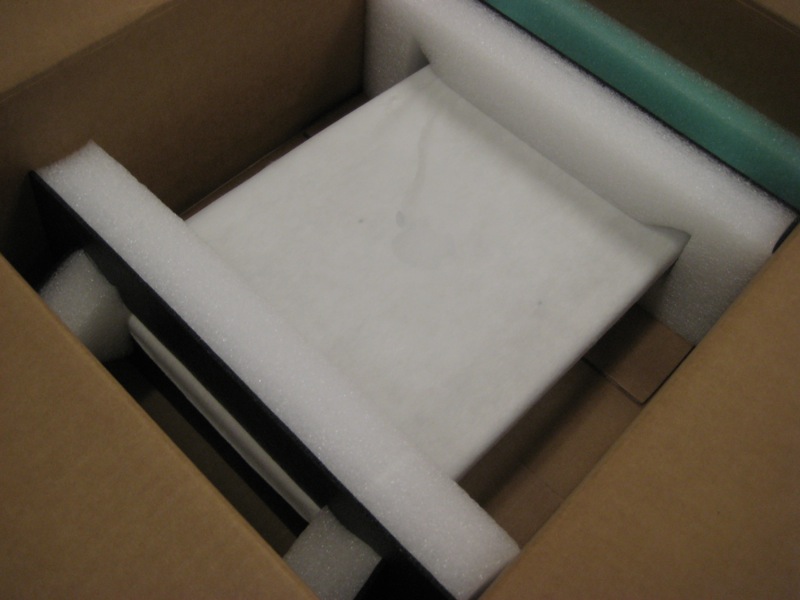Thursday, November 01, 2007
Punish the Cheap
Earlier this week, I bought a refurbished MacBook (right in time for Apple to update their offerings, so there you go).
Have you ever seen a photo of Apple's product packaging? Of course you have. It's so pretty nobody can resist.

Beautiful! Too bad I didn't get to keep this one. You could almost use that box as a carrying case.

Even the inside of the box is pretty. You'll have to trust me on this, but the MacBook ("MacBook Amateur"?) uses virtually the same packaging, in terms of quality and layout. Form-fitted styrofoam, nicely packaged accessories, a cute little well for the disc and documentation package.
So, what about a refurb--I'm sorry, Certified Reconditioned Product?

Very...brown. And gray.
So, the form-fitted foam inside?

Aaah! It burns! My eyes bleed!
I haven't shown the cardboard insert that sits atop this foam for holding the accessories, but it was even worse: nothing sat in it properly, and the smaller accessories actually rattled around, hidden from view in the folds of the cardboard insert, when I first opened the box.
Now, why is Apple doing this? The obvious reason is that it's a bit cheaper, and probably more universal for the short runs of refurb stuff. I think the rather generic cardboard box could hold almost any Mac from a Mini to a small iMac. And costs should matter: they offer a pretty generous discount on refurbs (more than their restocking fee, for example).
But I think this is also a marketing decision: buy the new product, get the nice box. Buy the refurb, get the crappy box. I suspect there's lots of subtle little marketing pressures that are being put on people to say "hey, you can buy this product, but here's lots of little almost-reasons not to."
Cheap people like me get punished in all kinds of ways. Some are simple and cruel, like buying a $2 vernier caliper at Princess Auto and finding out it's off by about 0.7mm. Some are complicated and funny, like my year-long quest for a power adapter after I bought a really nice bicycle headlight for $5. This Apple technique is fairly special: it's obvious and harmless.
I'll take it!
Have you ever seen a photo of Apple's product packaging? Of course you have. It's so pretty nobody can resist.

Beautiful! Too bad I didn't get to keep this one. You could almost use that box as a carrying case.

Even the inside of the box is pretty. You'll have to trust me on this, but the MacBook ("MacBook Amateur"?) uses virtually the same packaging, in terms of quality and layout. Form-fitted styrofoam, nicely packaged accessories, a cute little well for the disc and documentation package.
So, what about a refurb--I'm sorry, Certified Reconditioned Product?

Very...brown. And gray.
So, the form-fitted foam inside?

Aaah! It burns! My eyes bleed!
I haven't shown the cardboard insert that sits atop this foam for holding the accessories, but it was even worse: nothing sat in it properly, and the smaller accessories actually rattled around, hidden from view in the folds of the cardboard insert, when I first opened the box.
Now, why is Apple doing this? The obvious reason is that it's a bit cheaper, and probably more universal for the short runs of refurb stuff. I think the rather generic cardboard box could hold almost any Mac from a Mini to a small iMac. And costs should matter: they offer a pretty generous discount on refurbs (more than their restocking fee, for example).
But I think this is also a marketing decision: buy the new product, get the nice box. Buy the refurb, get the crappy box. I suspect there's lots of subtle little marketing pressures that are being put on people to say "hey, you can buy this product, but here's lots of little almost-reasons not to."
Cheap people like me get punished in all kinds of ways. Some are simple and cruel, like buying a $2 vernier caliper at Princess Auto and finding out it's off by about 0.7mm. Some are complicated and funny, like my year-long quest for a power adapter after I bought a really nice bicycle headlight for $5. This Apple technique is fairly special: it's obvious and harmless.
I'll take it!
Comments:
I got a refurb mac mini & it came in the same brown box. Guess what though, the mac mini didn't even turn on! I went to the nearest apple store, & they couldn't fix it, but they had an "opened box" mini (new, not refurb) that they gave me for 10% off, and we returned the refurb through the mail. Refurb means that there was something wrong with it & it got ~fixed, not that it was simply returned because someone didn't want it & payed a 10% restock fee. I am very wary of refurbs, but my "open box" mini came in the pretty store package, and they tested the hardware & software for me even though the people that bought it originally never used it.
Apple is deliberately ambiguous about what a refurbished product is before it gets refurbished. They describe the refurb process, with the disclaimer that "while only some units are returned due to technical issues, all units undergo Apple's stringent quality refurbishment process."
The short version of this is that refurbs are anything that gets returned to Apple, but is deemed resalable. This almost certainly includes DOAs, warranty cases, and yes, simple open-box returns to the online store.
A bricks-and-mortar Apple Store would have much more flexibility about distinguishing open-box and actually broken equipment. They probably hold the former for sale (as you experienced) and ship the latter for repairs, when not locally repairable.
Yeah, refurbs can be a crap-shoot. All computers are, but refurbs almost certainly get off to a worse start than normal new equipment.
I wasn't very interested in the provenance or nature of refurbs, because that's well-documented. I was more interested in the odd quirk of using a lower-class packaging system for the refurbs. There's reasons both psychological (economists might say "signalling") and practical for these bland refurb boxes.
Post a Comment
The short version of this is that refurbs are anything that gets returned to Apple, but is deemed resalable. This almost certainly includes DOAs, warranty cases, and yes, simple open-box returns to the online store.
A bricks-and-mortar Apple Store would have much more flexibility about distinguishing open-box and actually broken equipment. They probably hold the former for sale (as you experienced) and ship the latter for repairs, when not locally repairable.
Yeah, refurbs can be a crap-shoot. All computers are, but refurbs almost certainly get off to a worse start than normal new equipment.
I wasn't very interested in the provenance or nature of refurbs, because that's well-documented. I was more interested in the odd quirk of using a lower-class packaging system for the refurbs. There's reasons both psychological (economists might say "signalling") and practical for these bland refurb boxes.



